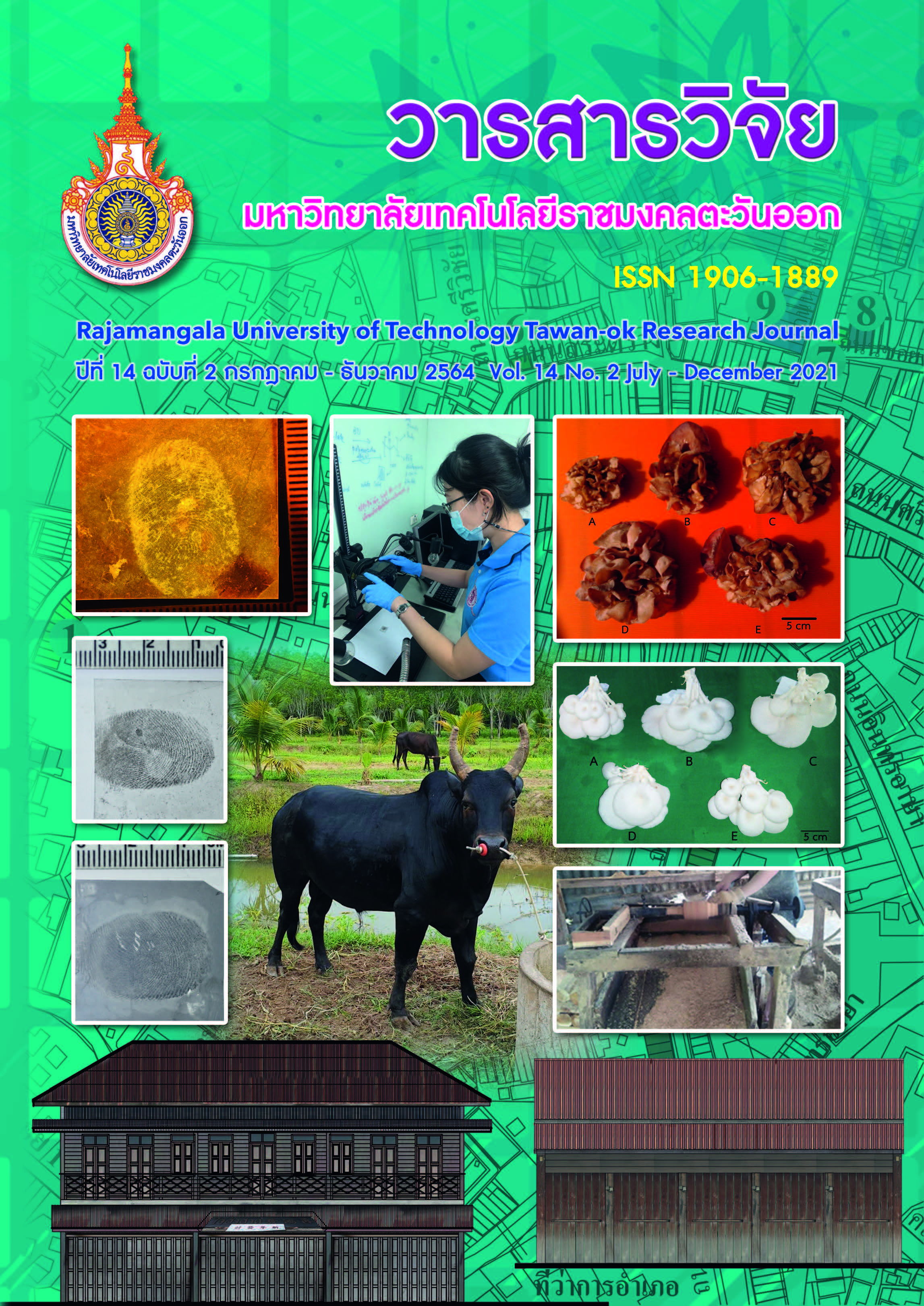Detection of latent fingerprints on the film of mobile phones that are submerged in water using black powder, Small particle reagent, Cyanoacrylate and Rhodamine 6G
Main Article Content
Abstract
There are many types of forensic evidence. Which evidence of latent fingerprints is often found at the scenes, especially in the case of some evidence submerged in water, such as the case of the assailant dropping a mobile phones into a water to escape arrest. Latent fingerprints on the mobile phone film may be one of the forensic evidence and identifiable criminals, this research has designed an experiment by study how to find latent fingerprints on the film of mobile phones that are submerged in water, including pipe water, river water and canal water. By taking the mobile phone film with a fingerprint stamped and soaking it in water for a period of 1, 3, 5, 7, 10, 14, 21 and 28 days before developing by the black powder, Small Particle Reagent (SPR),Cyanoacrylate and Rhodamine 6G (R6G). The results of the study found that when comparing the chemicals used to detect latent fingerprints on the film that are submerged in different types of water, it was found that the black powder can detect latent fingerprints and was good enough for comparison and identification. Although the films were immersed in water for 21 days, while Cyanoacrylate, SPR and R6G were able to detect latent fingerprints when immersed in water for no longer than 14, 5 and 7 days, respectively. When compared the latent fingerprints on the films in water under with different periods. It was found that at 1, 3 and 5 days for pipe water and river water,latent fingerprints are good quality. While the water in the canal is average quality. For 7 and 10 days, latent fingerprints in pipe water are still of good quality but for the river and canal water are average and low quality, respectively. At 14 days, pipe water remained of good quality, while the river is of low quality. At 21 days, pipe water is average quality, but water from the river is low quality. And at 28 days for pipe water, fingerprints are of low quality.
Article Details
References
ศิราภรณ์ อุไรรัตน์. 2556. การพัฒนาและทดสอบสารเคมีสำหรับเก็บรอยลายนิ้วมือแฝงบนพื้นผิวที่เปียกที่ไม่มีรูพรุน. วิทยานิพนธ์ปริญญาวิทยาศาสตรมหาบัณฑิต สาขาวิชานิติวิทยาศาสตร์ คณะวิทยาศาสตร์มหาวิทยาลัยศิลปากร.
ศิริรัตน์ เที่ยงเธียรธรรม. 2556. การปรากฏขึ้นของลายนิ้วมือแฝงบนวัตถุที่จมอยู่ในน้ำธรรมชาติโดยใช้ Small Particle Reagent และผงฝุ่นดำ. วิทยานิพนธ์ปริญญาวิทยาศาสตรมหาบัณฑิต สาขาวิชานิติวิทยาศาสตร์ คณะวิทยาศาสตร์มหาวิทยาลัยศิลปากร.
สุภาภรณ์ โจมฤทธิ์. 2554. การศึกษาวิธีการลอกเก็บลายนิ้วมือแฝงบนผิวหนังมนุษย์. วิทยานิพนธ์ปริญญา วิทยาศาสตรมหาบัณฑิต สาขาวิชานิติวิทยาศาสตร์คณะ วิทยาศาสตร์มหาวิทยาลัยศิลปากร.
เอกจิตตรา มีไชยธร. 2551. การศึกษาการปรากฏขึ้นของลายนิ้วมือแฝงบนกระดาษด้วยนินไฮดริน. วิทยานิพนธ์ ปริญญาวิทยาศาสตรมหาบัณฑิต สาขาวิชานิติวิทยาศาสตร์ คณะวิทยาศาสตร์มหาวิทยาลัยศิลปากร.
Ana Castelló, Francesc Francés and Fernando Verdú. 2013. Development of latent prints made on submerged objects. Science & Justice. 2013 (53): 328-331.
Boris Geller, Amihud Leifer, David Attias and Yanku Mark. 2018. Fingermarks in blood: Mechanical models and the color of ridges. Forensic Science International. 2018(286): 141-147.
Florine Halleza, Pierre Ledroitb, Damien Henrotb, Marianne Malob and Laurent Tamisierb. 2019. Optimization of the development of latent fingermarks on thermal papers. Forensic Science International. 2019(298): 20-33.
Matej Trapecar. 2012. Finger marks on glass and metal surfaces recovered from stagnant water. Egyptian Journal of Forensic Sciences. 2012(2): 48-53.
Matej Trapecar. 2012. Fingerprint recovery from wet transparent foil. Egyptian Journal of Forensic Sciences. 2012(2): 126-130.
Nancy Singlaa, Manvjeet Kaura and Sanjeev Sofatb. Automated latent fingerprint identification system: A review. Forensic Science International. 2020(309): 110187.


